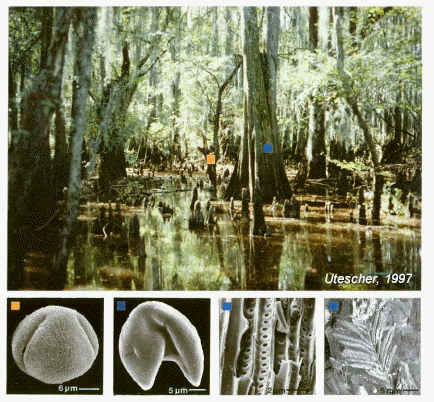The coexistence approach - a method for quantitative
reconstructions of Cenozoic terrestrial palaeoclimate from the palaeobotanical record
The coexistence approach (Mosbrugger and Utescher,
1997) is an efficient and reliable method for
quantitative terrestrial palaeoclimate reconstructions from the Cenozoic palaeobotanical
record. It is based on the assumption that fossil plant taxa have similar climatic
requirements as their nearest living relatives. The aim of the coexistence approach is to
find for a given fossil flora and a selected variable the climatic interval, in which all
nearest living relatives of the fossil flora can coexist.
 |
Quantitative terrestrial paleoclimate
reconstructions in the Cenozoic based on Nearest Living Relatives of the fossil taxa
Fossil remains from the upper part of the Miocene Rhenish Main
Seam (Northwest Germany, Middle Miocene) and their relatives in the Mississippi Swamp
Forest.
Nyssa (pollen)
Taxodium (pollen, wood, leafes)
|
For this purpose we have started in 1990 the
Palaeoflora database project, which actually contains for over 6000 Cenozoic taxa (macro
and micro) nearest living relatives and their climatic requirements. As algorithm for the
analyses the Program ClimStat is used.
For all types of fossil floras the
coexistence approach thus allows for the rapid quantitative reconstruction of 10 different
climate parameters, including mean annual temperature, temperature of the warmest month,
temperature of the coldest month, mean annual precipitation, mean precipitation of the
wettest month, mean precipitation of the dryest month, mean precipitation of the warmest
month, relative humidity, potential evaporation, as well as the ratio of mean annual
precipitation over potential evaporation.
The reliability and resolution of the
coexistence approach are tested with various techniques and proved to be very good; for
instance, the resolution with respect to the mean annual temperature can be up to 1° C.
Applications to various modern and fossil floras have demonstrated the advantages and
disadvantages of the coexistence approach.
A short course on the application
of the CA is available at the NECLIME website.
CA References
